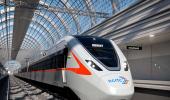Semi-high-speed 'Namo Bharat' train services on the 17-km priority section of India's first Regional Rapid Transit System (RRTS) rail corridor will be opened for people from Saturday morning.

Prime Minister Narendra Modi on Friday inaugurated this section of the Delhi-Ghaziabad-Meerut RRTS Corridor by unveiling a plaque at its Sahibabad station.
He also took a ride on a train of the system which seeks to redefine travel in the region with swift speed and latest technology.
The priority section, between Sahibabad and Duhai Depot, has five stations -- Sahibabad, Ghaziabad, Guldhar, Duhai and Duhai Depot.
The segment from Duhai to Duhai Depot is a spur from the main corridor.
"Passenger services will begin from October 21 morning. Trains will be operational between 6 am and 11 pm. Initially, trains will be available every 15 minutes, though the frequency can be increased on a requirement basis in the future," an official said.
The RRTS is a new rail-based, semi-high-speed, high-frequency commuter transit system with a design speed of 180 kmph, and operational speed potential of 160 kmph.
The foundation stone for the RRTS Delhi-Ghaziabad-Meerut Corridor was laid by Prime Minister Modi on March 8, 2019. The entire 82.15 km corridor is targeted to be operational by June 2025.
Once fully operational, the corridor would cut down the travel time between Delhi and Meerut to around 55 minutes from the current three to four hours by road.
Every 'Namo Bharat' train will have six coaches, including a premium coach. One coach in every train is reserved for women and it is the coach next to the premium coach. Seats in coaches are serially numbered, officials said.
There are also reserved seats for women, the specially-abled, and senior citizens in other coaches, they said.
Premium coaches have a seat with a different colour code, a provision for installing a vending machine, besides a host of additional commuter-centric features such as reclining seats, coat hooks, magazine holders and footrests.
Entry to a premium-class coach will be through a gated premium lounge at platforms. Every lounge has cushioned seats and a vending machine.
People can commute between Sahibabad and Duhai Depot stations on this line in about 12 minutes, the officials said.
A one-way journey from Sahibabad to Duhai Depot station on the priority section of this RRTS corridor will cost Rs 50, while the fare for the same route will be Rs 100 in a premium-class coach.
If a passenger enters from one station, say Sahibabad station and exits from the same station, then it will cost Rs 20.
Children having a height below 90 cm will be allowed to travel free, the National Capital Region Transport Corporation (NCRTC) said.
The RRTS corridor is being built by the NCRTC, a joint venture company of the Centre with the governments of Delhi, Haryana, Rajasthan, and Uttar Pradesh.
The NCRTC has been tasked to oversee the construction of India's first RRTS, between Delhi and Meerut.
The officials said commuters can buy a paper QR code-based ticket, which can be generated via ticket vending machines (TVM) or bought from ticket counters at stations, the officials said.
Unified Payments Interface or UPI-enabled ticket vending machines have been installed to purchase paper QR code-based tickets and recharge the National Common Mobility Card (NCMC).
Passengers can use bank notes, bank cards, NCMCs and UPI to buy tickets from a TVM, they said.
This priority section will also facilitate the movement of patients as one general coach in each train will have the space to accommodate a medical stretcher and a wheelchair.
Besides, some of the lifts installed at its stations are elongated for extra room to accommodate a stretcher, the officials said.
CCTV cameras, an emergency door-opening mechanism and a button to communicate with a train operator are among the safety features in trains.
For enhanced safety, every RRTS station is equipped with platform screen doors (PSDs). These PSDs are integrated with RRTS train doors and the signalling system.
A push-button facility on the doors of the trains will allow passengers to board and get off the train when it halts at a station, the officials said.
This step has been taken as a measure to 'save energy', they said, adding that the push-button only gets activated after a train comes to a halt at a station.
However, initially, the door operation in coaches will be done automatically, and train attendants and ground staff will assist passengers till they fully get used to this system, the officials said.
"The government of Uttar Pradesh has entrusted the responsibility of security of all the stations in the state to the Uttar Pradesh Special Security Force (UPSSF)," a senior official said.
Trains of the RRTS will be known as 'Namo Bharat', Union Minister Hardeep Singh Puri had announced on the eve of its inauguration. In April, the NCRTC had named RRTS trains as 'RAPIDX'.










